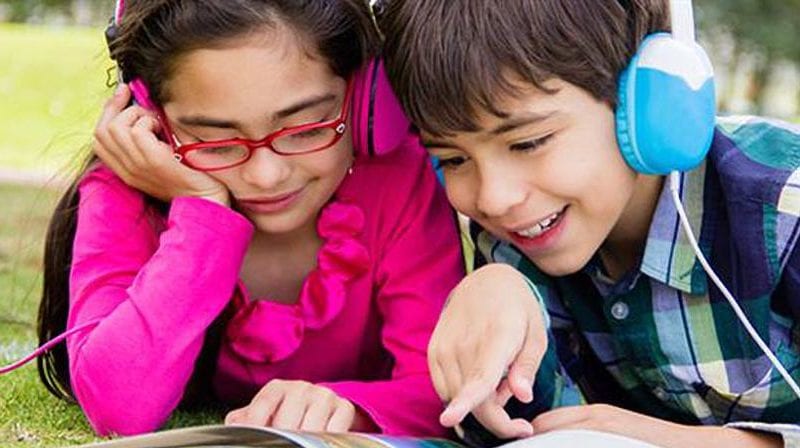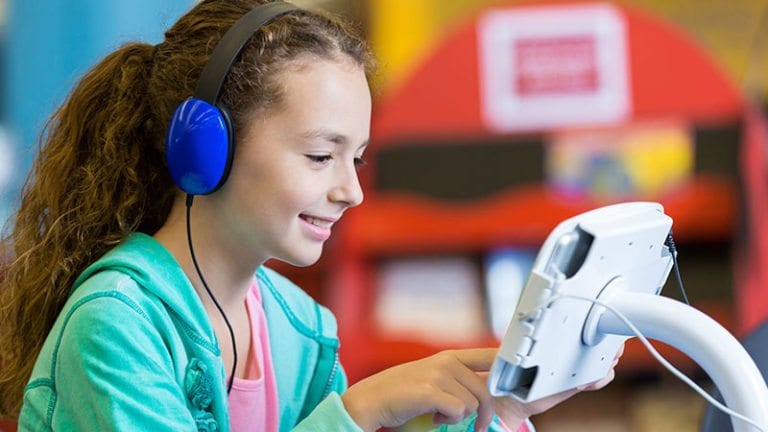Thirty second graders are sitting at their desks, entranced. The classroom lights are dimmed and the only sound is a suspenseful voice coming over a pair of speakers. The students are listening to the audio version of Michael Buckley’s Sisters Grimm series, part of a special tradition in Brown’s classroom. Every day after recess, Brown’s students spend ten minutes listening to a shared audiobook and then discussing what they heard as a class.
Brown says that it’s one of her favorite moments of the teaching day, and her students love it, too. While a few of them could read Buckley’s series on their own, most aren’t ready for it as independent readers. Yet the audiobooks allow everyone to participate in the experience, enjoying Buckley’s vivid characters, challenging vocabulary and rich, imaginative world.
Exposing all students to complicated storytelling, no matter their reading level, is just one benefit of using audiobooks in the classroom. But the research shows there are many other advantages too, including an increase in reading comprehension, motivation and self-confidence.
That’s why we’ve gathered 10 teacher-tested ideas for using audiobooks in the classroom, from ways to help your struggling readers to strategies for gifted learners and students with special needs. Read on to discover how you can use this assistive technology to help all kids fall in love with reading.
1. Model Joyful, Fluent Reading
Whether it’s Stockard Channing reading the Ramona books or Tim Curry narrating A Series of Unfortunate Events, part of the fun of listening to a story is the wonder and magic the reader brings to the performance. Stories come to life when read aloud, and as listeners we can see the characters and situations in new ways. You can describe fluency all you want, but nothing illustrates the concept more vividly than the animation a professional narrator brings to an audio recording.
“My class was so tickled by the audio version of James and the Giant Peach that I challenged them to create their own ‘audiobooks’ based on reading fluency, expression, and vocal emotion,” says Molly Jane Rosen, a fifth grade teacher in the Washington Heights neighborhood of New York City. After “grading” the professional recording using a fluency rubric, Rosen’s students went onto stage their own versions of the story. “They had a blast making their voices excited, neurotic, British, hopeful and all the myriad emotions only Roald Dahl can inspire,” says Rosen.
Audiobook Teaching tip: Have students evaluate a professional audio recording based on reading fluency, expression, and emotion. Then challenge students to employ the same criteria as they read aloud themselves.
2. Hook Readers
You don’t have to listen to an entire recording to reap the benefits of audiobooks in the classroom. Just a few minutes is often enough to introduce students to a new genre, author or literary technique, says Florida high school teacher Margaret Briskey. “When my students listen to an audiobook as a class, we do so in a variety of ways,” says Briskey. “Sometimes we listen only long enough to get ‘hooked’ on a story, sometimes we listen to select parts to heighten the suspense or read with a fluency the students don’t have, sometimes to get us through difficult pronunciations of unfamiliar words.”
From there, students can engage with the print version of the text or continue listening on their own. “When I have hooked a new listener I may loan him or her one of my iPods with the full audiobook loaded,” says Briskey. “I love when I am asked if I have any more ‘like that one.’”
Teaching tip: Try playing an audiobook clip from the middle rather than the beginning of a story. The heightened drama and excitement may inspire students to pick up the book on their own.
3. Differentiate using audiobooks in the classroom
When you have to reach 30 different readers with 30 different learning styles and capabilities, audiobooks can help you bridge the gap and keep students engaged in meaningful literacy activities. For example, fifth grade teacher Ashley Naul uses audiobooks to make literature circles work in her classroom. “While students do some reading aloud within their circles,” Naul says, “they also rotate to listening centers when I cannot join them for that class period. During this time, they listen to an audio version of the book. I don’t have to worry about confusion, off-task behavior or mispronunciation.”
Naul also uses audiobooks in the classroom to help catch up students who are absent due to illness, and to challenge her advance learners who may be ready for a new book sooner than their classmates.
Teaching tip: Set up a listening station in your classroom that contains tablets, computers or other playback devices, headphones and audiobooks. Post a list of instructions at the station so that students can easily begin work without your support.
4. Strengthen the School-Home Connection
Listening to an audiobook as a family can be a powerful shared experience, especially for students who don’t necessarily come from a print-rich environment. The recording can serve as a model for reading aloud for parents and offer opportunities for discussion and reflection as family.
Teaching tip: Try sending home an audiobook loaded on an iPod or a Kindle, with discussion questions and a journal for reflection, suggests first grade teacher Carmela Annicchiarico. The next day, invite the student to sit in a special spot and share his or her journal entry with the class.
5. Focus on a Literary Device
Whether you’re teaching personification, onomatopoeia, metaphor or hyperbole, listening to several audio clips that contain the device can often help students understand the concept quicker than reading it in print. Try playing three to five clips at the beginning of a lesson and challenging students to identify what the snippets have in common. Alternatively, once students have learned about a given literary term, you might ask them to journal each time it occurs in an audio recording.
Teaching tip: When students are giving oral book reports, ask them to play a favorite clip from the audio recording, then describe the literary techniques that makes the passage so effective.
6. Use Audiobooks in the Classroom to Engage With Nonfiction
With the Common Core’s increased emphasis on nonfiction, many teachers are looking for ways to integrate more informational text into the curriculum. Listening to nonfiction on audio can be a great way to pique the interest of students who may not be as familiar with biographies, science and history books as they are with novels and poetry. Playing audiobooks in the classroom can also help you illustrate key characteristics of nonfiction, such as the use of relevant details and domain-specific vocabulary. Sometimes hearing the concept can make it click better than seeing it in print.
Teaching tip: Look for nonfiction with vivid language and storytelling, such as Jim Murphy’s An American Plague or Tanya Lee Stone’s Almost Astronauts.
7. Use Audiobooks to Compare Versions of the Same Story
In addition to the greater importance placed on nonfiction, the Common Core also calls for students in middle school and above to “compare and contrast the experience of reading a story, drama or poem to viewing an audio, video, or live version of the text.” In other words, under the new standards, students need to be able to analyze the similarities and differences between a printed text and a performed version of the same story.
With audiobooks in particular, you might ask students how the narrator’s tone, pace and inflection affect the interpretation of a story’s characters, settings and events (e.g., Does the protagonist in the audio recording sound like students imagined? Why or why not?).
Teaching tip: Take the comparison a step further by analyzing two audio recordings of the same book read by different narrators (for example, Roald Dahl’s version of Charlie and the Chocolate Factory compared to Douglas Hodge’s).
8. Use Audiobooks to Serve Students with Special Needs
Audiobooks in the classroom can be the way into reading for students with a number of special needs, including vision impairments, sensory integration issues and learning delays. As middle school special education teacher Maggie Johanson puts it, “Audiobooks increase students’ comprehension skills as well as allow them to feel accomplished and talk about books that their friends are reading. This sense of accomplishment paired with a quality, engaging audiobook can instill the desire and love for reading in students that will last a lifetime!”
If you teach in an inclusion setting, you can have students with special needs listen along to the book that the rest of the class is reading in print. Or you can try assigning texts based on students’ reading levels—remembering that students listening comprehension is often beyond what they understand in print.
Teaching tip: Choosing a device for students with special needs can be just as important as delivering the right content. Some students may prefer listening to an audiobook on tablet, while others may prefer a smartphone, CD player, or special playback unit.
9. Use Audiobooks in the Classroom as an Incentive
It sounds simple, but the opportunity to listen to audiobooks in the classroom can be a powerful motivator for students, says Felicity Steers, a second grade teacher in Idaho. Steers likes to offer audiobooks as an option during free choice time, and she reports that it’s “always one of the first choices that gets snatched up!” To make it even more engaging, Steers allows students to listen in groups of up to three students. The result? Students “view reading as a fun and social event.”
Teaching tip: Rather than offer stickers or prizes to students who reach literacy milestones or goals, make reading its own reward by inviting students to spend classroom time listening to a favorite audiobook.
10. Invite Students to Record Their Own Audiobooks
Listening to great stories and reading aloud go hand in hand, so after your students have become familiar with a professional audiobook, challenge them to make their own versions of the same story. Second grade teacher Bernadine Lormilus recommends using an iPod or smartphone as a simple recording device, or alternatively a program such as iMovie to capture a full-blown filmed version of the tale. “My students love hearing themselves,” Lormilus says, “and they can judge whether or not they were reading fluently.”
Indeed, making your own audiobooks helps to close the circle of fluency and comprehension, developing students’ understanding that stories are both an art form and a means of communication.
Teaching tip: Make sure to share your personal audiobooks with students’ families, your school community or online. Spread the joy of listening to a terrific story being read aloud!
Audiobooks are a great tool for teachers to relax with too! Check out our favorite list here.

